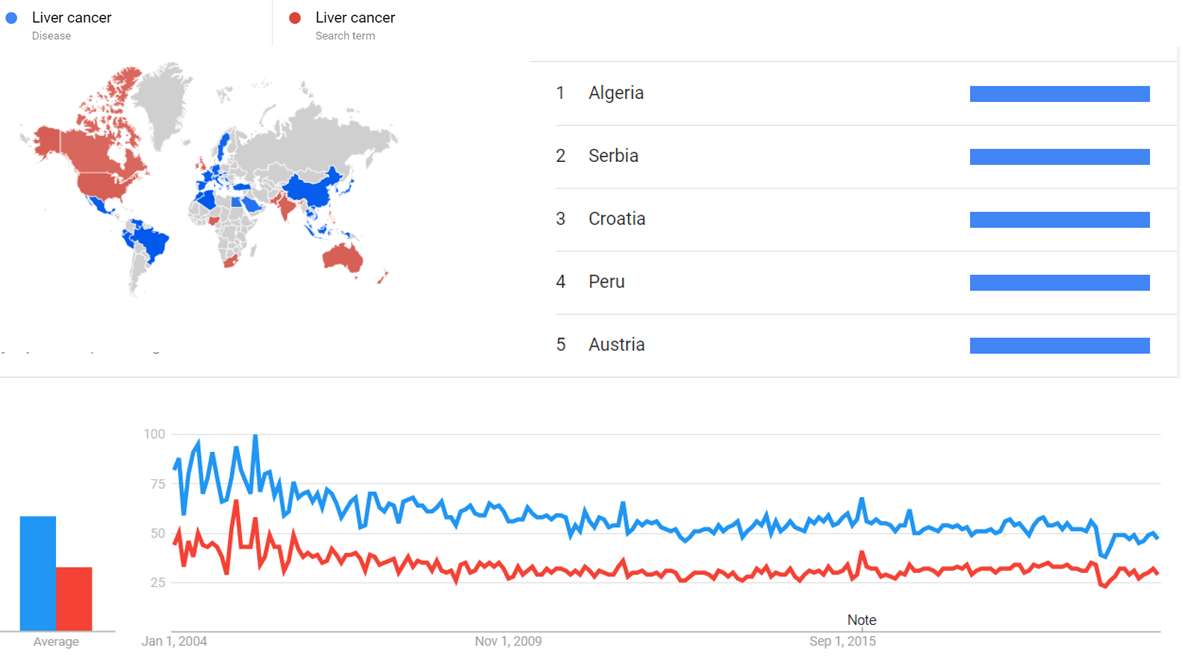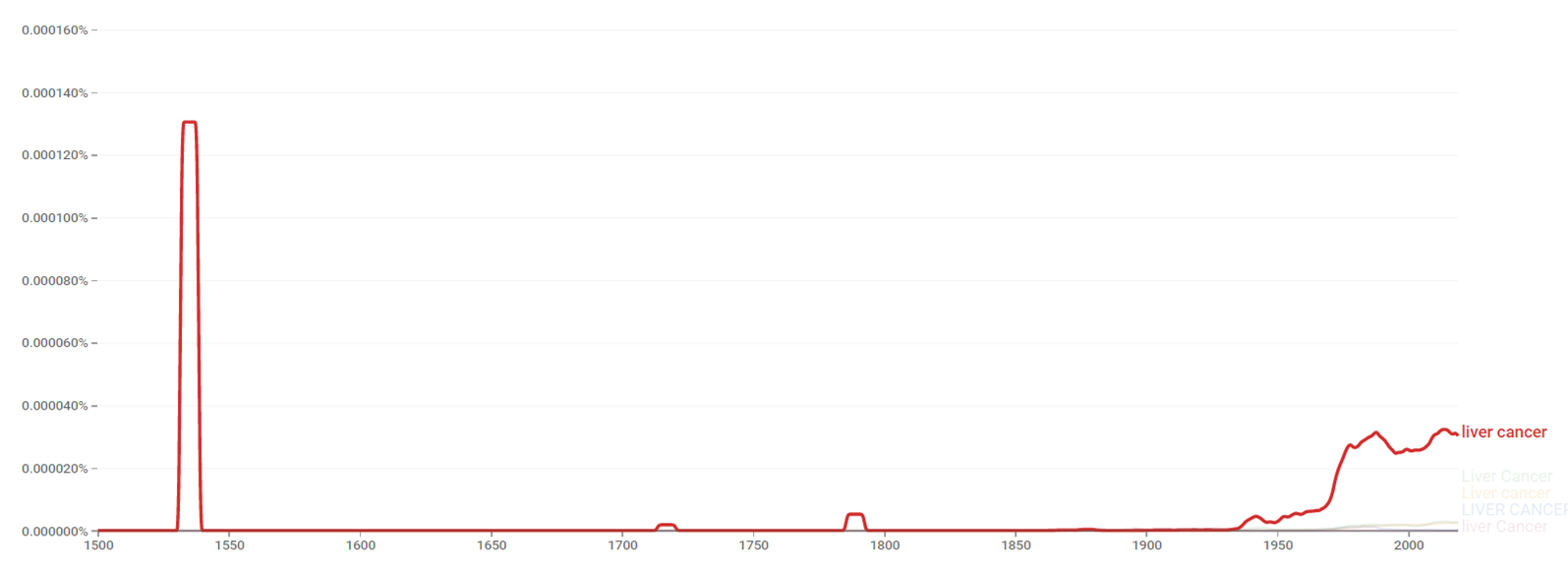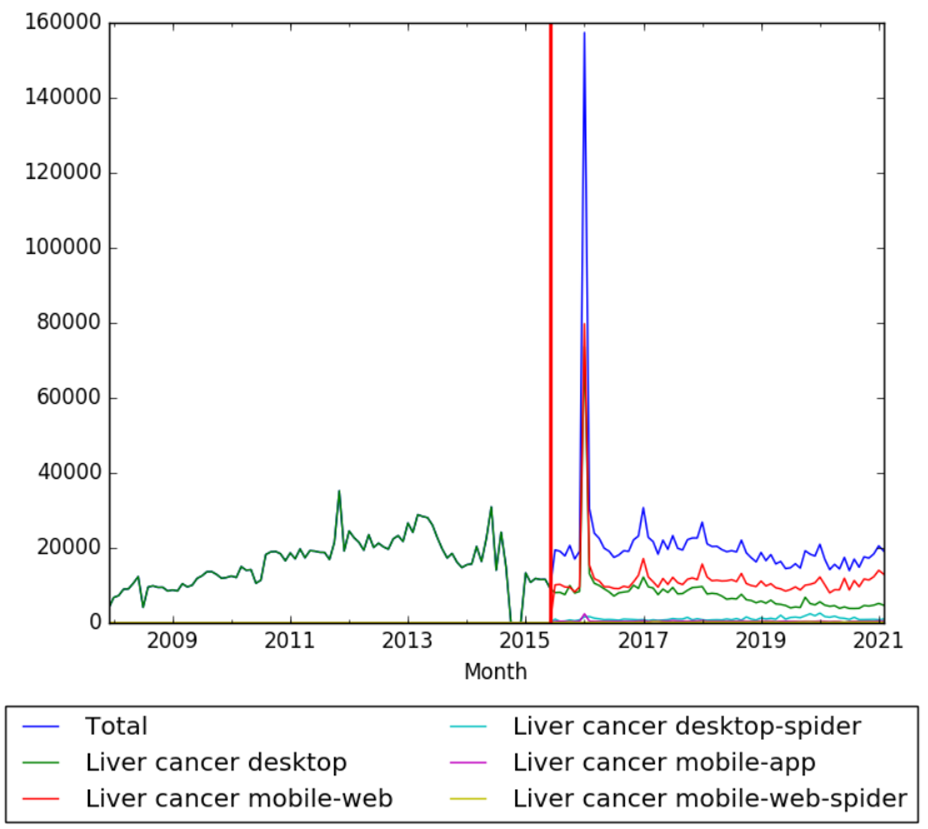Timeline of liver cancer
This is a timeline of liver cancer, describing especially major discoveries and advances in treatment of the disease.
Big picture
| Year/period | Key developments |
|---|---|
| 19th century | First recorded attempts of hepatic surgery.[1] |
| 1960s | Hepatitis B is found to be a leading cause of liver cancer.[2] First liver transplant performed. |
| 1980s | Tumor ablation develops.[2] |
| 1990s | Liver transplantation becomes a standard treatment for certain patients with liver cancer, extending life expectancy for years and sometimes leading to cure.[2] |
| 2000s | The introduction of sorafenib in considered to mark a new era of liver cancer research and treatments.[2] Obesity is linked to liver cancer deaths. |
| Recent years | As of 2010, liver cancer resulted in 754,000 deaths, up from 460,000 in 1990, making it the third leading cause of cancer death after lung and stomach.[3] Current treatment options for liver cancer are surgery, tumor ablation, tumor embolization, radiation therapy, targeted therapy and chemotherapy.[4] |
Full timeline
| Year/period | Type of event | Event | Location |
|---|---|---|---|
| 1870 | Development | First hepatic surgery is performed.[1] | |
| 1911 | Development | The first anatomical resection for liver cancer is performed during a right lobectomy.[1] | |
| 1950 | Organization | The American Association for the Study of Liver Diseases is founded as an organization of scientists and healthcare professionals committed to preventing and curing liver disease.[5] | United States |
| 1956 | Discovery | Fibrolamellar hepatocellular carcinoma (a rare form of hepatocellular carcinoma that typically affects young adults) is first described.[6] | |
| 1957 | Development | The first comprehensive description of the liver, including the identification of its eight functional sections, is published.[2] | |
| 1963 | Treatment | First liver transplant is performed in a patient with liver cancer.[7] | |
| 1964 | Development | Researchers introduce the first effective strategy to assess how well the liver is working, an important factor in treatment decisions for liver cancer.[2] | |
| 1965 | Treatment | Radioactive isotope Yttrium-90 (Y90) is first used for the treatment of inoperable liver cancer, for which previously there are no treatment options.[8] | |
| 1966 | Organization | The European Association for the Study of Liver Diseases is founded.[9] | Marburg, Germany |
| 1968 | Organization | The Latin American Association for the Study of the Liver (ALEH) is founded.[5] | Sao Paulo, Brazil |
| 1973 | Development | Child-Pugh score system develops as a method used to assess the prognosis of chronic liver disease. The system, which remains in use today, considers the results of three specific blood tests, the presence of fluid in the abdomen and cognitive function.[10] | |
| 1975 | Treatment | Research shows that advanced liver cancers respond to single-drug treatment with doxorubicin (Adriamycin).[11] | |
| 1981 | Treatment | United States FDA approves the first vaccine against hepatitis B, one of the primary causes of liver cancer.[12] | United States |
| 1983 | Treatment | A new technique called tumor ablation helps patients who cannot undergo surgery by shrinking and, in some cases, destroying smaller liver tumors.[13] | |
| 1983 | Treatment | Ultrasound-guided percutaneous ethanol injection in hepatic tumors is introduced.[14] | |
| 1989 | Treatment | Interstitial laser photocoagulation (ILP) for metastatic liver lesions is described. Since then, lasers are used to deliver local, controlled heat deposition in multiple organs.[13] | |
| 1991 | Discovery | Hepatitis C virus is first associated with hepatocellular carcinoma.[15] | |
| 1993 | Treatment | Percutaneous radio frequency ablation is introduced as a technique to treat liver tumors. The procedure is performed under ultrasound guidance. A small needle is inserted into the posterior aspect of the tumor, and ethanol is slowly injected into the lesion.[14] | |
| 1994 | Development | Researchers describe the infectious agent Helicobacter hepaticus and its role in causing active hepatitis and associated liver tumors in mice.[16] | |
| 1996 | Treatment | Research shows that liver transplantation is an effective treatment option for certain patients with cirrhosis and tumors that are confined to the liver.[17] | |
| 1998 | Discovery | Research links non-alcoholic steatohepatitis (NASH) to increased liver cancer risk.[18] | |
| 2002 | Discovery | Researchers discover that liver cancers develop as a result of disruptions along multiple pathways, resulting in many genetically varied forms of liver cancer.[19] | |
| 2003 | Discovery | Study links obesity to higher risk of death from liver cancer, along with several other cancer types.[20] | United States |
| 2006 | Organization | The International Liver Cancer Association (ILCA) is established. It is the only international organization devoted exclusively to liver cancer research for experts from all related disciplines.[21] | |
| 2007 | Treatment | Study shows that drug sorafenib (Nexavar), extends the lives of patients with advanced, inoperable hepatocellular carcinoma, the most common form of liver cancer.[22] | |
| 2008 | Development | New criteria provides detailed guidance to help doctors select patients most likely to benefit from liver transplants, based on tumor size, spread and response to previous therapy.[23] | |
| 2012 | Organization | The South Asian Association for the Study of the Liver is founded.[5] | Dhaka, Bangladesh |
| 2016 | Discovery | Study shows that liver cancer risk rises up to 10 times with low selenium levels in the blood.[24] | United States |
| 2016 | Treatment | Bayer’s Stivarga is found to improve liver cancer survival rates after trial.[25] | Germany |
Visual data
Google Trends
The comparative chart below shows Google Trends data Liver cancer (Disease) and Liver cancer (Search term), from January 2004 to March 2021, when the screenshot was taken. Interest is also ranked by country and displayed on world map.[26]

Google Ngram Viewer
The chart below shows Google Ngram Viewer data for Liver cancer, from 1500 to 2019.[27]

Wikipedia Views
The chart below shows pageviews of the English Wikipedia article Liver cancer, on desktop from December 2007, and on mobile-web, desktop-spider, mobile-web-spider and mobile app, from July 2015; to February 2021.[28]

See also
- Timeline of lung cancer
- Timeline of brain cancer
- Timeline of colorectal cancer
- Timeline of pancreatic cancer
- Timeline of cervical cancer
- Timeline of kidney cancer
References
- ↑ 1.0 1.1 1.2 Parks, RW; Garden, OJ (2001). "Liver resection for cancer". World J. Gastroenterol. 7: 766–71. doi:10.3748/wjg.v7.i6.766. PMC 4695590. PMID 11854897.
{{cite journal}}: CS1 maint: unflagged free DOI (link) - ↑ 2.0 2.1 2.2 2.3 2.4 2.5 "Progress & Timeline". Retrieved 30 September 2016.
- ↑ Lozano, R; Naghavi, M; Foreman, K; Lim, S; Shibuya, K; Aboyans, V; Abraham, J; Adair, T; Aggarwal, R; Ahn, S. Y.; Alvarado, M; Anderson, H. R.; Anderson, L. M.; Andrews, K. G.; Atkinson, C; Baddour, L. M.; Barker-Collo, S; Bartels, D. H.; Bell, M. L.; Benjamin, E. J.; Bennett, D; Bhalla, K; Bikbov, B; Bin Abdulhak, A; Birbeck, G; Blyth, F; Bolliger, I; Boufous, S; Bucello, C; et al. (Dec 15, 2012). "Global and regional mortality from 235 causes of death for 20 age groups in 1990 and 2010: a systematic analysis for the Global Burden of Disease Study 2010". Lancet. 380 (9859): 2095–128. doi:10.1016/S0140-6736(12)61728-0. PMID 23245604.
- ↑ "Liver cancer treatment". Retrieved 1 October 2016.
- ↑ 5.0 5.1 5.2 "Related Societies". Retrieved 30 September 2016.
- ↑ Darcy, DG; Chiaroni-Clarke, R; Murphy, JM; Honeyman, JN; Bhanot, U; LaQuaglia, MP; Simon, SM (2015). "The genomic landscape of fibrolamellar hepatocellular carcinoma: whole genome sequencing of ten patients". Oncotarget. 6: 755–70. doi:10.18632/oncotarget.2712. PMC 4359253. PMID 25605237.
- ↑ "Liver Transplantation". Retrieved 30 September 2016.
- ↑ Ariel, IM (1965). "Treatment of Inoperable Primary Pancreatic and Liver Cancer by the Intra-Arterial Administration of Radioactive Isotopes (Y90 Radiating Microspheres". Ann. Surg. 162: 267–78. doi:10.1097/00000658-196508000-00018. PMC 1476829. PMID 14327011.
- ↑ "EASL". Retrieved 30 September 2016.
- ↑ "The Child-Pugh score: Prognosis in chronic liver disease and cirrhosis". Retrieved 1 October 2016.
- ↑ "Treatment of hepatocellular carcinoma with adriamycin. Preliminary communication". Cancer. 36: 1250–1257. doi:10.1002/1097-0142(197510)36:4<1250::AID-CNCR2820360410>3.0.CO;2-X.
- ↑ "Hepatitis B VIS". Retrieved 1 October 2016.
- ↑ 13.0 13.1 van Sonnenberg, Eric; McMullen, William; Solbiati, Luigi. Tumor Ablation: Principles and Practice.
- ↑ 14.0 14.1 "Hepatocellular Carcinoma (Liver Cancer)". Retrieved 30 September 2016.
- ↑ "Risk Factors for the Rising Rates of Primary Liver Cancer in the United States". Retrieved 30 September 2016.
- ↑ "Helicobacter pylori and Liver – Detection of Bacteria in Liver Tissue from Patients with Hepatocellular Carcinoma Using Laser Capture Microdissection Technique (LCM)". doi:10.5772/57080.
{{cite journal}}: Cite journal requires|journal=(help) - ↑ "Liver Transplantation for the Treatment of Small Hepatocellular Carcinomas in Patients with Cirrhosis". New England Journal of Medicine. 334: 693–700. doi:10.1056/NEJM199603143341104.
- ↑ Hollingsworth, RC; Minton, EJ; Fraser-Moodie, C; Metivier, E; Rizzi, PM; Irving, WL; Jenkins, D; Ryder, SD. "Hepatitis G infection: role in cryptogenic chronic liver disease and primary liver cell cancer in the UK. Trent Hepatitis C virus Study Group". J Viral Hepat. 5: 165–9. doi:10.1046/j.1365-2893.1998.00102.x. PMID 9658369.
- ↑ "Molecular pathogenesis of human hepatocellular carcinoma". Nature Genetics. 31: 339–346. doi:10.1038/ng0802-339.
- ↑ Calle, EE; Rodriguez, C; Walker-Thurmond, K; Thun, MJ (April 2003). "Overweight, Obesity, and Mortality from Cancer in a Prospectively Studied Cohort of U.S. Adults". N. Engl. J. Med. 348: 1625–38. doi:10.1056/NEJMoa021423. PMID 12711737.
- ↑ "ILCA". Retrieved 1 October 2016.
- ↑ Llovet, JM; Ricci, S; Mazzaferro, V; et al. (July 2008). "Sorafenib in Advanced Hepatocellular Carcinoma". New England Journal of Medicine. 359: 378–390. doi:10.1056/NEJMoa0708857. PMID 18650514.
{{cite journal}}: Explicit use of et al. in:|last4=(help) - ↑ Yao, FY; Kerlan, RK Jr; Hirose, R; Davern; Bass, NM; Feng, S; Peters, M; Terrault, N; Freise, CE; Ascher, NL; Roberts, JP. "Excellent outcome following down-staging of hepatocellular carcinoma prior to liver transplantation: an intention-to-treat analysis". Hepatology. 48: 819–27. doi:10.1002/hep.22412. PMC 4142499. PMID 18688876.
- ↑ "Liver cancer risk influenced by blood selenium levels". Medical News Today. Retrieved 30 September 2016.
- ↑ "Bayer's Stivarga improves liver cancer survival rates, trial shows". Retrieved 30 September 2016.
- ↑ "Liver cancer". Google Trends. Retrieved 9 March 2021.
- ↑ "Liver cancer". books.google.com. Retrieved 9 March 2021.
- ↑ "Liver cancer". wikipediaviews.org. Retrieved 9 March 2021.
Template:Cancer timeline Cancer, liver Category:Hepatology Category:Digestive system neoplasia C